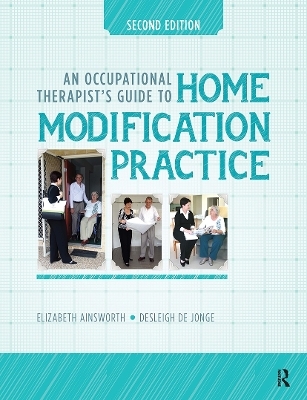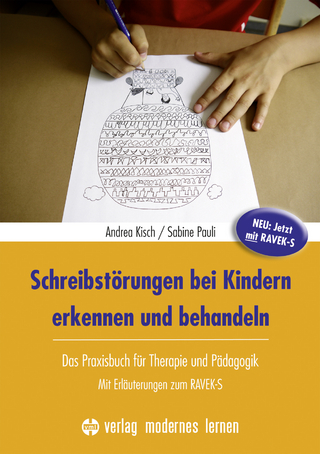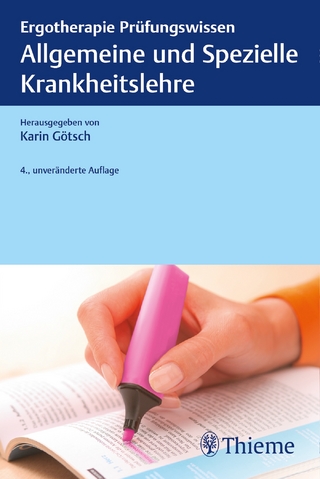
An Occupational Therapist’s Guide to Home Modification Practice
SLACK Incorporated (Verlag)
978-1-63091-218-5 (ISBN)
Occupational therapists are well suited to determining the most appropriate home modification solutions to address environmental barriers. They possess the knowledge and skills necessary to evaluate people’s current and future needs in the context of the nature and use of the environment and can work collaboratively with design and construction professionals to develop solutions.
To be comprehensive and effective in their approach, occupational therapists need to understand not only the individual’s requirements, but also, the ethical and legal contexts for practice, the technical aspects of the built environment, the relevance and intent of access standards and design approaches, and the application of a range of products and finishes.
An Occupational Therapist’s Guide to Home Modification Practice, Second Edition by Elizabeth Ainsworth and Desleigh de Jonge and their team of expert contributors provides comprehensive information to inform occupational therapists about current practice and research. This includes the authors using a transactional approach to examine the person-occupation-environment interaction and providing occupational therapists with a detailed understanding of the various dimensions of the home environment that can impact on client’s home modification decisions.
New material has been provided relating to research and practice issues, such as an overview of the latest home modification outcome research findings as documented in literature; an update on outcome evaluation; new research information about the dimensions of the home impacting on decision making; additional information grabrail and ramp prescription; and the inclusion of new case studies illustrating minor and major modification solutions for clients who present with diverse needs.
In the Second Edition you’ll find:
A detailed understanding of aspects of the home environment that impact home modification decisions
A review of legislative environment and funding systems that facilitate service delivery
An overview of home modification services, as well as future trends
A range of comprehensive case studies — illustrated by photographs
Additional theory to inform knowledge, and skill development, that can be used in home modification practice worldwide
Included with the text are online supplemental materials for faculty use in the classroom..
An Occupational Therapist’s Guide to Home Modification Practice, Second Edition provides a range of resources and tools, and it can be used as a teaching aid to support students, interns, and novice therapists or as a manual for reflection and practice for more experienced home modification practitioners.
Elizabeth Ainsworth, MOccThy, Grad Cert Health Sci graduated in 1989 with a bachelor of occupational therapy (honors) degree and completed a master’s in occupational therapy (contemporary clinical practice at the University of Queensland) and a graduate certificate in health science (environmental modifications at the University of Sydney) in 2000. She is a private practice occupational therapist, accredited and qualified access consultant, and PhD candidate at The University of Queensland. Elizabeth has had over 20 years’ experience aiding older people and people with disabilities who require home modifications or alternative housing. She has a history of working in government and non-government agencies that assist people living in a range of housing tenures such as private and social housing and private rental accommodation. Elizabeth provides consultancy services to clients and their families, and to organizations, about housing and home modification solutions. She also completes medico legal work, providing information to the courts in Australia and overseas about the housing and home modification needs of people who have had complex or catastrophic injuries. She provides home modification and universal design education and training to occupational therapy university undergraduate and postgraduate students and to occupational therapy clinicians working in a range of settings in the community, both in Australia and overseas. She is a member of the Australian Network for Universal Housing Design (ANUHD), Universal Design Australia, the Australian Access Consultants Association (ACAA), the Australian Rehabilitation and Assistive Technology Association (ARATA), and Values in Action. Desleigh de Jonge, MPhil (OccThy), Grad Cert Soc Sci graduated in 1978 with a bachelor of occupational therapy from The University of Queensland, completed a master’s in philosophy in 2001, and is currently completing a PhD at this university. She has over 35 years’ clinical experience as an occupational therapist and 12 years teaching and research at the School of Health and Rehabilitation Sciences at The University of Queensland, where she currently holds an honorary research title. Her teaching and research is focused on interventions and outcome measures that recognize client goals and priorities. Desleigh’s national and international reputation in client-oriented analysis of assistive technologies, environmental design, and home modifications has earned her invitations to present at international conferences on assistive technology and home modification services and outcomes in the United States and Australia, and she has been published extensively in national and international journals. Desleigh was on the editorial board of Disability and Rehabilitation: Assistive Technology from 2006 to 2012 and regularly reviews articles for national and international journals. Elizabeth and Desleigh have worked together for at least 18 years to provide training to occupational therapy students and practitioners. They have presented at national and international conferences on home modifications and universal design to a broad range of people from various backgrounds. The second edition of this book is testament to their dedication to equipping occupational therapists to achieve quality home modification outcomes for older people and people with disabilities internationally.
Dedication Acknowledgments About the Authors Contributing Authors Preface Foreword Chapter 1 The Home Environment Chapter 2 Approaches to Service Delivery Chapter 3 Models of Occupational Therapy Chapter 4 Legislation, Regulations, Codes, and Standards Influencing Home Modification Practice Chapter 5 The Home Modification Process Chapter 6 Evaluating Clients' Home Modification Needs and Priorities Chapter 7 Measuring the Person and the Home Environment Chapter 8 Drawing the Built Environment Chapter 9 Developing and Tailoring Interventions i Chapter 10 Sourcing and Evaluating Products and Designs Chapter 11 Access Standards and Their Role in Guiding Interventions Chapter 12 Ethical, Legal, and Reporting Variables: Pathways to Best Practice Chapter 13 Evaluating Outcomes Chapter 14 Literature Review: Home Modification Outcomes for Older Adults and Adults With Disabilities Chapter 15 Case Studies Appendix A Minor Modifications: It's Not as Simple as Do It Yourself (DIY)Appendix B Outline of Shapes and Occupied Wheelchairs Appendix C Fundamental Types of Compact Turns Appendix D Ramp Installation Considerations Appendix E Home Modification Practice Resources Appendix F Access Standards Resources Appendix G Home Visit Checklist Appendix H Home Modification Report Template Appendix I Example of an Occupational Therapy Report s Index
| Erscheinungsdatum | 14.07.2018 |
|---|---|
| Verlagsort | Thorofare |
| Sprache | englisch |
| Maße | 216 x 279 mm |
| Gewicht | 1592 g |
| Themenwelt | Sachbuch/Ratgeber ► Gesundheit / Leben / Psychologie |
| Medizin / Pharmazie ► Physiotherapie / Ergotherapie ► Ergotherapie | |
| ISBN-10 | 1-63091-218-2 / 1630912182 |
| ISBN-13 | 978-1-63091-218-5 / 9781630912185 |
| Zustand | Neuware |
| Haben Sie eine Frage zum Produkt? |
aus dem Bereich


